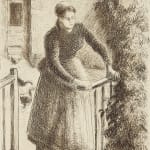Camille Pissarro (1831-1903)
Woman at the Gate (Femme a la Barrière), 1889
Etching and drypoint on laid Arches paper
175 x 105 mm. (6 7/8 x 4 1/8 inches)
Signed in pencil with the initials 'CP', annotated 'imprime par C.P.' & 'No. 3, 6 etat' & titled 'femme a la barriere' (largely erased)
Delteil 84 sixth state (of ten)
Pissarro printed Woman at the Gate himself, working through successive states as he experimented with slight variations from state to state and, as was his typical printmaking practice, making only...
Pissarro printed Woman at the Gate himself, working through successive states as he experimented with slight variations from state to state and, as was his typical printmaking practice, making only one or a few impressions of each state and then omitting any edition. Here, he added the two ducks and the chicken in the yard just to the left of the woman (her right) in the third state (only 1 proof of this state), and added some shadow lines to the peasant’s dress and the house in the 4th and 5th states. In this impression, the sixth state, he added some lines to the leaves of the trees and clarified the hair of the woman. He printed (personally) three proofs of the sixth state, each annotated and numbered (1 to 3, this is 3). He made small changes in states 7, 8; darkened the plate quite a bit in state 9, and in state 10 added a layering of aquatint. Some lifetime impressions were made of state 10, and another group of 12 impressions in the 10th state were printed posthumously (of course these later impressions do not withstand comparison in aesthetic terms to the lifetime impressions).
The Impressionists, especially Pissarro and his printmaking partner Degas, approached printmaking as an evolutionary medium. It allowed them to have a composition evolve through successive states; the initial state or states were not viewed as merely a prelude to some definitive finality, but rather as a representation of one impression of the subject, and the last state generally represented the point at which they abandoned the print, not as the place to print an edition (and typically no edition, at least no lifetime edition, was made).
Even within states Pissarro experimented with different papers and inks; e.g., we’re aware of one impression of the 7th state (of 3 altogether) printed in bistre, and other impressions printed in black; this impression is printed in a brown ink which contrasts well with the light brown tint of this paper.
The Impressionists, especially Pissarro and his printmaking partner Degas, approached printmaking as an evolutionary medium. It allowed them to have a composition evolve through successive states; the initial state or states were not viewed as merely a prelude to some definitive finality, but rather as a representation of one impression of the subject, and the last state generally represented the point at which they abandoned the print, not as the place to print an edition (and typically no edition, at least no lifetime edition, was made).
Even within states Pissarro experimented with different papers and inks; e.g., we’re aware of one impression of the 7th state (of 3 altogether) printed in bistre, and other impressions printed in black; this impression is printed in a brown ink which contrasts well with the light brown tint of this paper.



